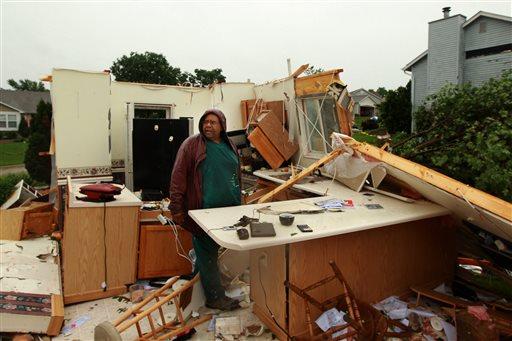It will take several days to assess the total damage of several tornadoes that swept through the Oklahoma region May 31. Officials confirmed that the storms, the ensuing hail and floods killed nine, wounded 75 and left 86,000 people without power.
The storm toppled cars and left commuters trapped on an interstate highway as it bore down during Friday’s evening rush hour near Oklahoma City. The National Weather Service reported several tornadoes rolled in from the prairie, terrifying towns along their paths.
The storms brought another tense day for a region still reeling from the recent top-of-the-scale EF5 tornado that struck the Oklahoma City suburb of Moore on May 20, killing 24 and decimating neighborhoods. Many said they took severe weather warnings issued during the day Friday seriously.
Numerous tornados split from a super cell thunderstorm to leave the region gasping. “We really needed a break after last [week], and there’s just no rest,” city spokeswoman Kristy Yager told CNN.
Mayor Glenn Lewis said: “This is unbelievable that it could possibly even hit again ... We just started picking up [debris] two days ago.”
Violent weather also moved through the St. Louis area. Early aerial images of the storm’s damage showed homes with porches ripped away, roofs torn off and piles of splintered wood scattered across the ground for blocks. Officials in St. Charles County also reported that local schools suffered some damage.
Among the five dead were a mother and a baby found in a vehicle in Oklahoma. Amy Elliott, a spokeswoman for the state medical examiner, said early Saturday that she had no immediate word of additional fatalities. At least 75 people were hurt, five critically, hospital officials said.
The Friday storm was not as bad as the one from May 20, but it delivered a lot of hail and rain, causing severe flooding. It dumped around 8 inches of rain on Oklahoma City in the span of a few hours flooding even the first floor of City Hall.
“We’ve seen widespread flooding throughout the entire 621 square miles,” Ms. Yager told CNN.
“We are overwhelmed right now with calls of people trapped in vehicles in high water, to the point that we are having grave difficulty even responding to all of them,” Lt. Jay Barnett of the Oklahoma City Police Department told NewsOK.
“The flooding is the major problem in the Oklahoma City metro. A lot of that has to do with people who, for whatever reason, instead of sheltering decided to outrun the storm and got caught in it,” he added.
Storms carrying rain makes it difficult for people to drive, as it drastically reduces visibility. Many parts of I-40 and I-35 where jammed with cars and officials described them as a “parking lot.” Motorists wanted to flee the area after the severe weather warning Friday, but could not advance due to the storm.
During such storms, people are advised to hide in bathtubs or under tables provided they don’t have an underground shelter. The weather warning told people to seek underground shelter, which led many people to get into their cars and seek refuge elsewhere, according to NewsOK.
Emergency officials reported that numerous injuries occurred in the area along I-40, and Randolph said there were toppled and wrecked cars littering the area. Standing water was several feet deep, and in some places it looked more like a hurricane had passed through than a tornado.
“We are trying to get there, but hurricane-force winds and low visibility are preventing us from getting there,” Lara O'Leary, spokeswoman for the Emergency Management Services Authority ambulance service, told NewsOK.
More than 86,000 utility customers were without power, as power lines were torn down along the state Highway 66 near I-40 between El Reno and Yukon.
Will Rogers World Airport sheltered several thousand people in a tunnel, said airport spokeswoman Karen Carney, as flights were cancelled and access roads blocked by floods.
“We still have a terminal full of people,” Carney said.
Violent weather also moved through the St. Louis area. Early aerial images of the storm’s damage showed groups of homes with porches ripped away, roofs torn off and piles of splintered wood scattered across the ground for blocks. Officials in St. Charles County also reported that local schools suffered some damage.
The chances for severe weather are on the decline, however, as a cold front moves through the region, said weather service meteorologist Gene Hatch in Springfield, Mo.
The U.S. averages more than 1,200 tornadoes a year and most are relatively small. Of the 60 EF5 tornadoes to hit since 1950, Oklahoma and Alabama have been hit the most — seven times each.
National Weather Service meteorologists said Saturday that it’s unclear how many tornadoes touched down as part of the Friday evening storm system. Dozens of tornado warnings were issued for central Oklahoma and parts of Missouri, especially near St. Louis, they said, but crews must assess the damage before determining whether it was caused by tornadoes or severe thunderstorms.
This spring’s tornado season got a late start, with unusually cool weather keeping funnel clouds at bay until mid-May. The season usually starts in March and then ramps up for the next couple of months.
The Associated Press contributed to this report.





